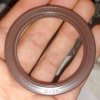First - thanks to @eemsreno for special tools, shop, and assistance in doing this job.
If your whole rear wheel looks like this from oil weeping from the bottom of the swing arm it is most likely a bad seal and/or O-ring in the front of the final drive.

It was a slow leak. I needed to add a couple ounces of oil after 1,000 miles.
After reading of other's issues I ordered all the seals and the coupler gear which I anticipated would have a groove worn in it. The coupler gear is the most expensive item and was on backorder for a few weeks.
After removing the wheel and final drive you have to remove the drive shaft. It pulls out from the final drive, only held in by the flexible seal. This one required significant pounding to separate (wood block and big hammer). The circlip does not need to be removed unless you replace that seal. Mine was not leaking so reused that seal for now.

Next remove the coupler gear nut. We used an impact driver.

Next the bearing retainer ring. Left hand threads with the special nut wrench. The ring comes out with the seal and O-ring.

Removing the seal from the ring was a bear but it did come out with significant pounding. As anticipated, the seal had worn a small groove in the coupler gear so we used the new one.
Find a cylinder the size of the seal to seat it. This was the best Steve had and it did the job.


Grease the o-ring, install and torque the bearing retainer nut. (Left hand threads)


Next is the coupler gear nut. Tough to torque without a holder. Tried using the wheel but the drive would still rotate even trying to hold it with a board. Finally resorted to the impact driver then staked the nut. Looking back at the picture, we probably could have used some straps around the tire and drive to keep the drive from rotating. You do need some longer handles to get the specified torques.

Reinstall the spring and driveshaft, reseating the flexible seal. Reinstall the drive and wheel. Refill the final drive. Spun it some during refill to ensure any voids were filled.
At 90,000 miles this is a fairly rare repair. I believe the old seal was just old and brittle. I'm keeping the old couple gear for the rework posted in another thread.
Sent from my SM-N950U using Tapatalk
If your whole rear wheel looks like this from oil weeping from the bottom of the swing arm it is most likely a bad seal and/or O-ring in the front of the final drive.

It was a slow leak. I needed to add a couple ounces of oil after 1,000 miles.
After reading of other's issues I ordered all the seals and the coupler gear which I anticipated would have a groove worn in it. The coupler gear is the most expensive item and was on backorder for a few weeks.
After removing the wheel and final drive you have to remove the drive shaft. It pulls out from the final drive, only held in by the flexible seal. This one required significant pounding to separate (wood block and big hammer). The circlip does not need to be removed unless you replace that seal. Mine was not leaking so reused that seal for now.

Next remove the coupler gear nut. We used an impact driver.

Next the bearing retainer ring. Left hand threads with the special nut wrench. The ring comes out with the seal and O-ring.

Removing the seal from the ring was a bear but it did come out with significant pounding. As anticipated, the seal had worn a small groove in the coupler gear so we used the new one.
Find a cylinder the size of the seal to seat it. This was the best Steve had and it did the job.


Grease the o-ring, install and torque the bearing retainer nut. (Left hand threads)


Next is the coupler gear nut. Tough to torque without a holder. Tried using the wheel but the drive would still rotate even trying to hold it with a board. Finally resorted to the impact driver then staked the nut. Looking back at the picture, we probably could have used some straps around the tire and drive to keep the drive from rotating. You do need some longer handles to get the specified torques.

Reinstall the spring and driveshaft, reseating the flexible seal. Reinstall the drive and wheel. Refill the final drive. Spun it some during refill to ensure any voids were filled.
At 90,000 miles this is a fairly rare repair. I believe the old seal was just old and brittle. I'm keeping the old couple gear for the rework posted in another thread.
Sent from my SM-N950U using Tapatalk
Last edited:







